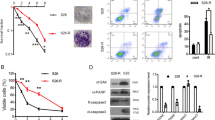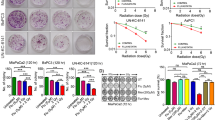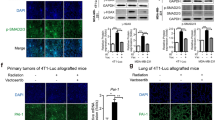Abstract
This study is to investigate the molecular mechanism of radiation-enhanced cell invasiveness of hepatocellular carcinoma (HCC) correlating with clinical patients undergoing radiotherapy and subsequently developing metastasis. Three HCC cell lines (HepG2, Hep3B and Huh7) and normal hepatocyte cell line (CL-48) were irradiated with different doses. The effect of radiation on cell invasiveness was determined using the Boyden chamber assay. Radiation-enhanced invasion capability was evident in HCC cells but not in normal hepatocytes. Invasion was observed in gelatin-coated but not fibronectin-coated or type I collagen-coated membranes. Radiation upregulated matrix metalloproteinase-9 (MMP-9) mRNA level, MMP-9 protein level and MMP-9 activity. MMP-9 antisense oligonucleotides inhibited radiation-induced MMP-9 expression and thereby significantly inhibited radiation-induced HCC invasion. Furthermore, phosphatidylinositol 3-kinase (PI3K)/Akt chemical inhibitors LY294002 and wortmannin suppressed radiation-induced MMP-9 mRNA expression. Transient transfection with dominant-negative Akt plasmid also showed that the PI3K/Akt-signaling pathway was involved in this radiation-induced MMP-9 expression. Moreover, nuclear factor-κB (NF-κB) decoy oligodeoxynucleotide suppressed radiation enhanced MMP-9 promoter activity completely. PI3K/Akt chemical inhibitors inhibited radiation-induced NF-κB-driven luciferase promoter activity. Taken together, our results indicated that sublethal dose of radiation could enhance HCC cell invasiveness by MMP-9 expression through the PI3K/Akt/NF-κB signal transduction pathway.
This is a preview of subscription content, access via your institution
Access options
Subscribe to this journal
Receive 50 print issues and online access
$259.00 per year
only $5.18 per issue
Buy this article
- Purchase on Springer Link
- Instant access to full article PDF
Prices may be subject to local taxes which are calculated during checkout







Similar content being viewed by others
References
Agarwal A, Das K, Lerner N, Sathe S, Cicek M, Casey G et al. (2005). Oncogene 24: 1021–1031.
Aguayo A, Patt YZ . (2001). Semin Oncol 28: 503–513.
Akimoto T, Mitsuhashi N, Saito Y, Ebara T, Niibe H . (1998). Int J Radiat Oncol Biol Phys 41: 1171–1176.
Camphausen K, Moses MA, Beecken WD, Khan MK, Folkman J, O'Reilly MS . (2001). Cancer Res 61: 2207–2211.
Cheng JC, Chuang VP, Cheng SH, Lin YM, Cheng TI, Yang PS et al. (2001). Int J Cancer 96: 243–252.
Chung TW, Lee YC, Kim CH . (2004). FASEB J 18: 1123–1125.
Criswell T, Leskov K, Miyamoto S, Luo G, Boothman DA . (2003). Oncogene 22: 5813–5827.
Dent P, Yacoub A, Contessa J, Caron R, Amorino G, Valerie K et al. (2003). Radiat Res 159: 283–300.
Fu KK, Phillips TL . (1991). Hematol Oncol Clin North Am 5: 737–751.
Hegedus B, Zach J, Czirok A, Lovey J, Vicsek T . (2004). J Neurooncol 67: 147–157.
Huang SC, Ho CT, Lin-Shiau SY, Lin JK . (2005). Biochem Pharmacol 69: 221–232.
Kim J, Yu W, Kovalski K, Ossowski L . (1998). Cell 94: 353–362.
Kuyvenhoven JP, van Hoek B, Blom E, van Duijn W, Hanemaaijer R, Verheijen JH et al. (2003). Thromb Haemost 89: 718–725.
Liang S-X, Zhu X-D, Lu H-J, Pan CY, Li FX, Huang QF et al. (2005). Cancer 103: 2181–2188.
London CA, Sekhon HS, Arora V, Stein DA, Iversen PL, Devi GR . (2003). Cancer Gene Ther 10: 823–832.
Moon SK, Cha BY, Kim CH . (2004). J Cell Physiol 198: 417–427.
Murawaki Y, Ikuta Y, Okamoto K, Mimura K, Koda M, Kawasaki H . (2000). Res Commun Mol Pathol Pharmacol 108: 351–357.
Nakashio A, Fujita N, Tsuruo T . (2002). Int J Cancer 98: 36–41.
Nirmala C, Jasti SL, Sawaya R, Kyritsis AP, Konduri SD, Ali-Osman F et al. (2000). Int J Cancer 88: 766–771.
O-charoenrat P, Wongkajornsilp A, Rhys-Evans PH, Eccles SA . (2004). Int J Cancer 111: 174–183.
Onoda JM, Piechocki MP, Honn KV . (1992). Radiat Res 130: 281–288.
Qian LW, Mizumoto K, Urashima T, Nagai E, Maehara N, Sato N et al. (2002). Clin Cancer Res 8: 1223–1227.
Ruhul Amin AR, Senga T, Oo ML, Thant AA, Hamaguchi M . (2003). Genes Cells 8: 515–523.
Sato H, Seiki M . (1993). Oncogene 8: 395–405.
Steinle JJ, Meininger CJ, Forough R, Wu G, Wu MH, Granger HJ . (2002). J Biol Chem 277: 43830–43835.
Sugioka Y, Watanabe T, Inagaki Y, Kushida M, Niioka M, Endo H et al. (2004). Int J Cancer 109: 867–874.
Susskind H, Hymowitz MH, Lau YH, Atkins HL, Hurewitz AN, Valentine ES et al. (2003). Int J Radiat Oncol Biol Phys 56: 1161–1169.
Thant AA, Nawa A, Kikkawa F, Ichigotani Y, Zhang Y, Sein TT et al. (2000). Clin Exp Metastasis 18: 423–428.
Wang JL, Sun Y, Wu S . (2000). Mol Carcinog 27: 252–258.
Wei LH, Lai KP, Chen CA, Cheng CH, Huang YJ, Chou CH et al. (2005). Oncogene 24: 390–398.
Wild-Bode C, Weller M, Rimner A, Dichgans J, Wick W . (2001). Cancer Res 61: 2744–2750.
Woo JH, Park JW, Lee SH, Kim YH, Lee IK, Gabrielson E et al. (2003). Cancer Res 63: 3430–3434.
Yao JS, Chen Y, Zhai W, Xu K, Young WL, Yang GY . (2004). Circ Res 95: 364–371.
Zijlstra A, Mellor R, Panzarella G, Aimes RT, Hooper JD, Marchenko ND et al. (2002). Cancer Res 62: 7083–7092.
Acknowledgements
This work was supported by the National Science Council, Execute Yuan, Taiwan, ROC (Grant number: NSC93-2323-B-002-009 & NSC94-2323-B-002-012), the Department of Health (Grant number: CCMP94-RD-016), and the research grants NTUH 94N25 and NTUH 95N04 National Taiwan University Hospital.
Author information
Authors and Affiliations
Corresponding author
Rights and permissions
About this article
Cite this article
Cheng, JH., Chou, C., Kuo, M. et al. Radiation-enhanced hepatocellular carcinoma cell invasion with MMP-9 expression through PI3K/Akt/NF-κB signal transduction pathway. Oncogene 25, 7009–7018 (2006). https://doi.org/10.1038/sj.onc.1209706
Received:
Revised:
Accepted:
Published:
Issue Date:
DOI: https://doi.org/10.1038/sj.onc.1209706
Keywords
This article is cited by
-
RIT1 Promotes Glioma Proliferation and Invasion via the AKT/ERK/NF-ĸB Signaling Pathway
Journal of Molecular Neuroscience (2022)
-
Mutation-specific non-canonical pathway of PTEN as a distinct therapeutic target for glioblastoma
Cell Death & Disease (2021)
-
PB01 suppresses radio-resistance by regulating ATR signaling in human non-small-cell lung cancer cells
Scientific Reports (2021)
-
Bystander effects induced by electron beam-irradiated MCF-7 cells: a potential mechanism of therapy resistance
Breast Cancer Research and Treatment (2021)
-
Role of RASEF hypermethylation in cigarette smoke-induced pulmonary arterial smooth muscle remodeling
Respiratory Research (2019)



